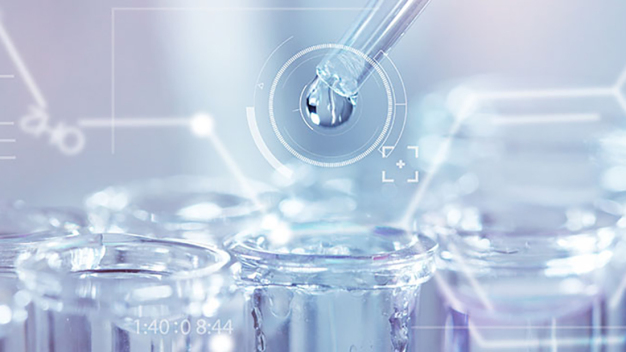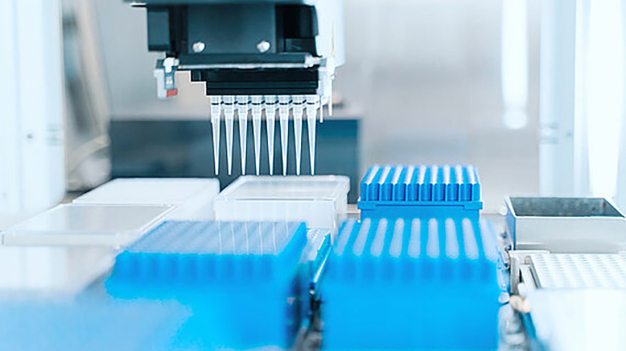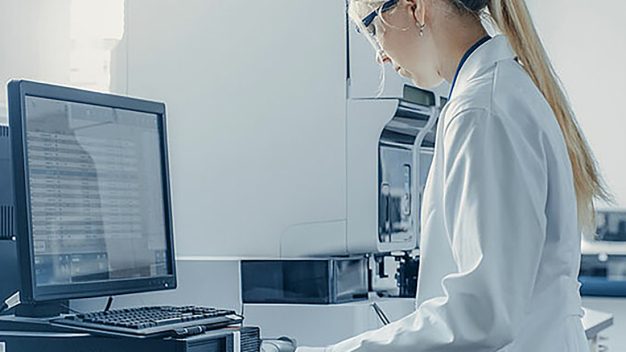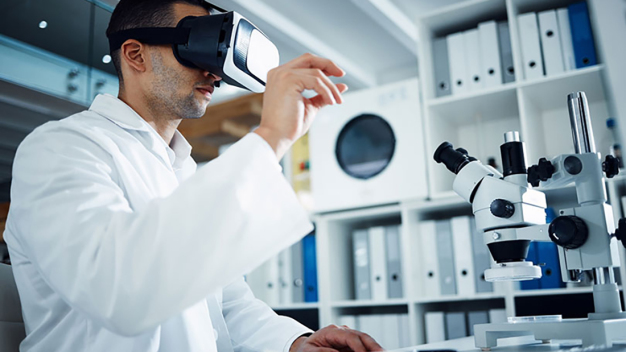- Trade fair
Christian Lüttmann
From data glasses to robotic arms – labs enter the digital age
The same developments happening in the rest of the world are also reshaping laboratories: the increasing use of technology, digital tools and, of course, robots and artificial intelligence (AI). All these trends often go hand in hand with a greater awareness of environmental issues. In this trend report, we present a summary of the fruits these developments are already bearing and will bear in the future.
The laboratory landscape is constantly changing. Whereas until the middle of the 20th century people used their mouths to suck up samples when pipetting, today's laboratories are equipped with the appropriate technical aids to protect laboratory staff and make their work easier. However, development has obviously not stopped with pipettes and is now progressing rapidly, especially in the areas of automation, digitalisation and robotics. We take a closer look at these major laboratory trends and how they can also benefit sustainability.
In the beginning was automation
It almost seems like a relic of a bygone era: in the 1970s, as the third industrial revolution (Industry 3.0) pushed the working environment more and more towards automated processes. This led to an increase in production output and created new opportunities in manufacturing and engineering. At the same time, laboratories began to move away from routine manual work towards more mechanical support. However, it was not until the Fourth Industrial Revolution, in the wake of digitalisation, that the formal breakthrough occurred. Since then, progress in this area has been promoted and discussed under the buzzword Laboratory 4.0.
The combination of basic tasks such as stirring, tempering, dosing, etc. in automated processes laid the foundation for faster and more repeatable laboratory work. Nowadays, virtually every piece of laboratory equipment is at least partially automated – from the HPLC system with pump unit and autosampler, to the fermenter with precisely controlled temperature technology and media supply, to the electronic pipette with support function for predefined workflows.
When we talk about automation in the laboratory today, it is inextricably linked to digitalisation. "It is important to remember that digitalisation alone is not enough – especially in the laboratory, automation also includes a strong hardware component," says Prof. Dr Kerstin Thurow from the Centre for Life Science Automation (CELISCA) at the University of Rostock. Without suitable equipment and systems for handling samples and labware, she says, it is not possible to automate laboratory processes. "This is often overlooked or taken for granted in today's discussion," she notes.
Ideally, a device combines automation and digitisation, as many workstations do. These devices are usually equipped with their own software that allows users to save their own workflows without the need for programming skills. For example, pre-defined steps can be dragged and dropped into the system to develop drug screens on a PC, which are then automatically performed by a pipetting station. This gives users more time for complex laboratory tasks such as planning and evaluating experiments.
From automats to auto-arms
In addition to workstations, which usually fulfil a narrowly defined task, robotic arms, familiar from industrial applications, are increasingly being used in the laboratory. "In addition to classic Cartesian liquid handling robots, various types of robotic arms are used when highly complex systems consisting of several devices need to be connected," explains automation expert Thurow. This type of robotic arm, which is most commonly associated with automotive manufacturing, can perform flexible movements that would otherwise only be possible by a human arm – and it can do so with the precision, endurance and repeatability of a machine. This is useful for sample transfer or preparation, for example, and particularly in project-based environments where workflows and tasks change more frequently and require a more flexible solution.
To accommodate a robot assistant in the laboratory, which is usually already constrained by a lack of space, modern robot arms are usually so-called cobots, short for collaborative robots. Their advantage is that they can be safely integrated into a shared workspace with a human, without the need for physical separation.
It is conceivable that in the future, robotic assistants will take over simple and tedious tasks from laboratory staff. "Kevin", an autonomous cobot developed by the Fraunhofer Institute for Automation Technology, is already in use in real laboratories. This cobot moves independently around the laboratory, taking samples and transporting them between the reception area, the analysis laboratory and the archive. According to automation expert Thurow, this type of mobile robot has the best chance of fundamentally changing laboratory work in the future. "It will further increase the degree of automation, especially in highly complex distributed systems. However, she believes that there will never be a fully autonomous laboratory. "Solutions will always be tailored to specific processes," says Thurow.
Flood of data
Apart from the physical tasks performed by robots and other machines, data generation is usually the main focus, or at least an essential part of the work, in the laboratory context. Since the beginning of the computer age, we have seen a rapid increase in the speed and volume of data generated.
This has inevitably been accompanied by the development of tools to assist laboratory staff in the acquisition, maintenance and analysis of data. These include laboratory information and management systems (LIMS), which would probably not exist without the growing flow of data. These systems help with documentation, sample management and act as an interface to the various instruments used in the laboratory. This makes process and sample traceability easier or possible, allowing accredited laboratories to comply with regulations at a reasonable cost.
Communication is key
In general, interfaces are an extremely important issue in the laboratory world. For some time now, there have been efforts to put an end to the days of proprietary software and to enable the much-vaunted "plug and play" capability across different manufacturers without any restrictions – in other words, simply plug in a new spectrometer and it is immediately recognised in the existing laboratory network and ready for use. Although this is already happening in many cases, there is still much to be done. The two initiatives SiLA and OPC UA LADS are particularly noteworthy in this respect. Both aim to create a common standard for instrument connectivity in the laboratory.
One reality is not enough
When it comes to the usability of a new or first-time laboratory set-up, it is not just the question of interfaces that comes into play, but also general planning aspects such as the sensible location of equipment, the space available and even the complete planning of media supply and the set-up of new workstations. Virtual reality (VR) has already gained a foothold in the laboratory sector. For example, a pre-created digital twin of the laboratory can be explored interactively and immersively, laboratory furniture can be placed and modified, and users can discuss and visualise changes with the laboratory planners in the virtual space. This transforms traditional site visits into meetings that can be held from anywhere by simply logging in – provided there is a stable internet connection.
A related technology, Augmented Reality (AR), superimposes digital information on the user's view of the real world. This technology has great potential to improve the quality of work in the laboratory, although it is still a long way from being used in everyday work. The possibilities are endless: step-by-step workflows guided by text displayed in data glasses, highlighting of required equipment or chemicals in the field of view, or repair instructions for an analytical instrument are just a few examples. Users may still have to get used to this form of assistance. It is conceivable that this technology will soon become socially acceptable in the wake of Apple's recently introduced VR glasses.
When machines start to learn
The emergence of the ChatGPT chatbot and its clones, which have generated a huge media hype in a very short time, shows how quickly a technological leap can take place. The possibilities offered by such learning algorithms will also change the world of laboratory work. A suitably trained programme could, for example, help with documentation and writing publications. Or it could simply act as an intermediary between humans and computer programmes, allowing them to design and control measurements via text or voice input – in direct dialogue with the analytical instrument, so to speak. In 2022, Lauda, the manufacturer of temperature control technology, made its first attempts at voice control for the laboratory with its Lauda Live system. The advantage is obvious: manual data entry is no longer necessary, leaving the hands free for other tasks.
The green lab of the future
Laboratories will gradually become more connected, digitalised and automated. In the future, we may even achieve the much touted 'paperless laboratory' – although in some cases we are still some way off. However, there is one aspect that seems to be the counterpoint to all this technological progress that will have a decisive influence on the laboratory of the future: the issue of sustainability.
The desire for a more sustainable laboratory is by no means synonymous with a desire for less technology, but rather relies on new technologies. Dr Thorsten Teutenberg of the Institute for Environment and Energy, Technology and Analytics (IUTA) confirms this: "Initially, digitalisation offers the greatest potential for advancing sustainability in the laboratory." According to Teutenberg, this is due, for example, to better organisation and documentation. "In many academic institutions, experiments are often repeated that have already been carried out several times, but by a different person who may not have worked at that institution for a long time. By using, for example, an electronic lab notebook instead of a paper-based lab notebook, research results can be made permanently available and unnecessary experiments can be avoided".
Another positive side-effect in terms of sustainability is the miniaturisation of laboratory equipment and processes, such as switching from classic HPLC to micro-LC. Such modifications ideally free up valuable space in the laboratory. "If we can save space by miniaturising analytical systems, this has a direct impact on the running costs of the laboratory," explains Teutenberg.
Miniaturisation of equipment and experimental set-ups down to lab-on-a-chip for minimal resource consumption, an AI-optimised reaction approach that achieves the desired result faster, or simply a freezer with lower energy consumption – many modern developments implicitly support the idea of sustainability in the laboratory.
Bottom line
From automation and robotics to digitalisation, AI and greater sustainability: Laboratories are in a constant state of flux. How quickly the laboratory world actually changes depends not only on the advancement of these technologies, but also on the people who use them in their daily work. And sometimes it takes a while for something new to catch on, whether it's the first LIMS or futuristic-looking AR data glasses for labs.
DECHEMA Ausstellungs-GmbH
60486 Frankfurt am Main
Germany












